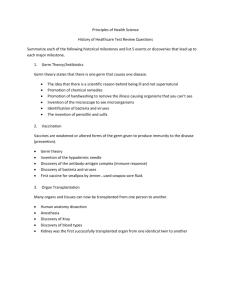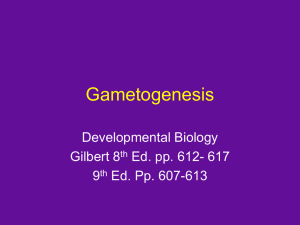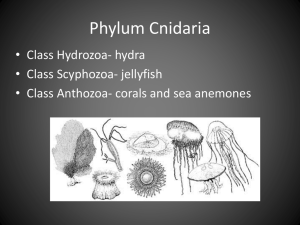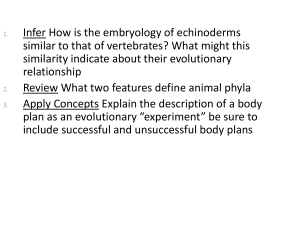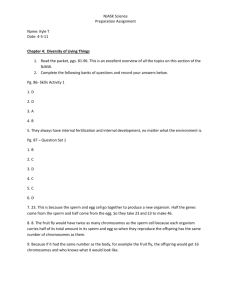BIOLOGY 624 Fall 2009 DEVELOPMENTAL GENETICS
advertisement
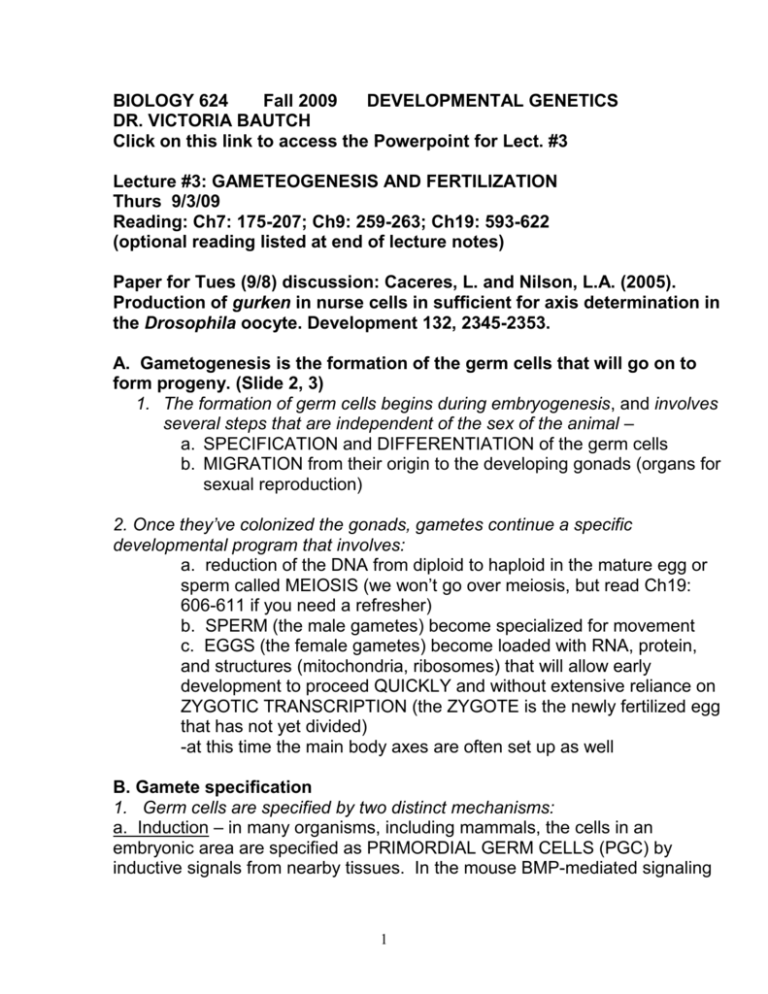
BIOLOGY 624 Fall 2009 DEVELOPMENTAL GENETICS DR. VICTORIA BAUTCH Click on this link to access the Powerpoint for Lect. #3 Lecture #3: GAMETEOGENESIS AND FERTILIZATION Thurs 9/3/09 Reading: Ch7: 175-207; Ch9: 259-263; Ch19: 593-622 (optional reading listed at end of lecture notes) Paper for Tues (9/8) discussion: Caceres, L. and Nilson, L.A. (2005). Production of gurken in nurse cells in sufficient for axis determination in the Drosophila oocyte. Development 132, 2345-2353. A. Gametogenesis is the formation of the germ cells that will go on to form progeny. (Slide 2, 3) 1. The formation of germ cells begins during embryogenesis, and involves several steps that are independent of the sex of the animal – a. SPECIFICATION and DIFFERENTIATION of the germ cells b. MIGRATION from their origin to the developing gonads (organs for sexual reproduction) 2. Once they’ve colonized the gonads, gametes continue a specific developmental program that involves: a. reduction of the DNA from diploid to haploid in the mature egg or sperm called MEIOSIS (we won’t go over meiosis, but read Ch19: 606-611 if you need a refresher) b. SPERM (the male gametes) become specialized for movement c. EGGS (the female gametes) become loaded with RNA, protein, and structures (mitochondria, ribosomes) that will allow early development to proceed QUICKLY and without extensive reliance on ZYGOTIC TRANSCRIPTION (the ZYGOTE is the newly fertilized egg that has not yet divided) -at this time the main body axes are often set up as well B. Gamete specification 1. Germ cells are specified by two distinct mechanisms: a. Induction – in many organisms, including mammals, the cells in an embryonic area are specified as PRIMORDIAL GERM CELLS (PGC) by inductive signals from nearby tissues. In the mouse BMP-mediated signaling 1 (BMP is a signal in the TGF-beta superfamily) from the extraembryonic ectoderm to embryonic cells nearby starts things off (Slide 4). b. Autonomous specification by cytoplasmic determinants in the egg that come to be included in the germ cell cytoplasm. In worms, frogs, and flies this pole plasm (or polar granules) contain specific RNAs and proteins. (Slide 5-7) BRIEF EXPLANATION OF A VERY IMPORTANT CONCEPT IN DEVELOPMENT – THE GENETIC COMPOSITION OF AN ORGANISM (ESPECIALLY A FEMALE) CAN PROFOUNDLY AFFECT HER OFFSPRING, AND EVEN THE PROGENY OF HER OFFSPRING. This is because in many organisms (frog and fly are good examples) early development very much depends on deposition of RNAs and proteins into the egg by the mother. Thus if the mother is missing a protein or RNA usually deposited into the eggs, she is fine but cannot deposit it into her eggs, so they develop abnormally. This is called a MATERNAL EFFECT MUTATION (Slide 8). It is less common in organisms such as mammals that do not place many determinants into their eggs, but with mammals females can carry mutations that affect their ability to nurture embryos. For example, if a mammalian mother is missing a gene required for formation of the maternal placenta, she will be OK but not able to produce offspring. They will die because the placenta does not form properly. How could a mutation affect grandchildren? 2. Back to germ cell specification. We will go through the process in flies as an example: a. during the nuclear divisions in the early fly embryo, a group of nuclei migrate to the posterior end where the pole plasm resides. If nuclei are prevented from reaching this spot no germ cells are formed. b. the future germ cells (called POLE CELLS) are cellularized slightly before the rest of the cells. c. if a gene called germ cell-less is missing, the female fly cannot have grandchildren, because her embryos do not have proper pole plasm. Thus the embryos themselves develop, but they lack germ cells and are sterile. (Slide 9) 3. What is in the pole plasm that specifies germ cells? This has been a big mystery for many years, and we are still not completely sure how this works, but it seems that perhaps the autonomous germ cell determinants prevent transcription and translation. The idea is that the germ 2 cells are “held” in a primitive or totipotent state by prevention of further differentiation. This may also be the case for germ cells specified by inductions – the signals may prevent further development. a. For example, in worms an early promoter is activated in all blastomeres except P, which will give rise to germ cells (Slide 10). b. germ cell less encodes a protein that goes to the nucleus of pole cells and prevents transcription. How it does this is not clear. It can also induce some cells to become germ cells if ectopically expressed (Slide 11). c. The fly pole plasm includes the protein OSKAR, which is required for germ cell formation. Oskar can also induce ectopic germ cells. It seems to localize other required components for germ cell formation such as NANOS mRNA. Nanos also can block transcription. (Note: Oskar also specifies the posterior axis of the embryo, see below). d. Exception: VASA is found in pole plasm and PGC of many organisms, it encodes a RNA helicase that may translationally activate a subset of RNAs required for germ cell formation. C. Gamete migration 1. Once germ cells are specified, they can migrate relatively long distances from origin to gonad. This migration in some situations may be “passive”, that is the whole tissue moves relative to others (especially during gastrulation) and the germ cells are along for the ride. However, there is clearly an “active” component as well, where germ cells migrate independent of surrounding tissue. 2. Details differ among different organisms, and we will use germ cell migration in the mouse as an example, because we do know some molecular requirements. a. Description – mouse PGCs are induced in the posterior epiblast around day 6.5 of development (just before gastrulation). They stay there for several days, then exit on day 9 and wander around for awhile. By day 10 they begin to migrate up the dorsal mesentery and into the genital ridge, area that will become the gonad (testes or ovary). (Slide 12, 13) b. Cellular mechanism - unknown, but fibronectin (FN) likely to be important, because PGCs that lack the integrin receptor for FN do not reach the gonads. c. Molecular control: 3 1) The cells that line the migration path express a ligand called stem cell factor (SCF) that promotes survival and proliferation of PGC. The PGC express the receptor c-kit. This pathway provides for survival and proliferation during migration and may also provide the spatial cues. (This pathway is also important in long range migration of neural crest cells and hematopoietic cells) 2) Recently it was found that a chemokine used for lymphocyte trafficking called SDF1 (stromal cell derived factor 1) and its receptor CXCR4 are required for the last migration of PGC into the gonad, but not for earlier movements. D. Spermatogenesis We won’t spend much time on spermatogenesis, not because it is not important but the process of oogenesis is more complex and more intimately linked to subsequent development of the embryo. -- Contrasts with Oogenesis – see Table 19.1 (p. 612 Gilbert) a. continuous production of gametes upon puberty b. meiosis is completed, then differentiation proceeds c. most material lost upon differentiation: what is retained is nuclear material, a structure called the ACROSOME that is important for fertilization, an energy source (mitochondria), and a highly specialized tail for movement. (Slide 14) E. Oogenesis – PGCs that enter female gonads and survive (there is a massive die-off before and right after birth) undergo oogenesis, which in addition to producing a haploid gamete via meiosis, provide the oocyte with nutrition and RNAs and proteins that usually control early developmental events. In many cases the major axes of the embryo (anterior-posterior and dorsal-ventral) are set up. How does this happen? 1. There are different modes for different types of oocytes, two examples of differences: a. the mammalian oocyte is surrounded by granulosa cells that provide material to the oocyte via gap junctions, vs. the fly oocyte that is connected to its nurse cells by cytoplasmic bridges, and is also in the same clonal lineage with the nurse cells. (Slide 15, 16) b. the frog oocyte nucleus is transcriptionally active (Slide 17), producing much of the egg material in this way, whereas the fly oocyte 4 nucleus supports very little transcription, instead the nurse cells become polytene and make most egg material. 2. Much is known about fly oogenesis so we will follow that process as an example. IN GENERAL, MATERNAL DETERMINANTS (RNAS AND PROTEINS) ARE DEPOSITED TO SPECIFIC REGIONS OF THE OOCTYE, BUT THERE IS AN ACTIVE PROCESS INVOLVING THE MICROTUBULES THAT FURTHER LOCALIZES THE INFORMATION AND STABILIZES ITS LOCATION. These movements are critical to setting up the major axes of the future embryo, the A-P and D-V axes. a. The fly oocyte develops in a germarium, which consists of the oocyte and nurse cells they are clonally related to, surrounded by follicle cells. (Slide 18) b. The oocyte sits asymmetrically in the germarium because the posterior follicle cells are more adhesive (more DE-cadherin). This occurs because cells in the previous germarium (there is a whole line of them like beads on a string) affect the adhesiveness of these cells via a Notch-Delta signal. c. The oocyte produces a protein called GURKEN (EGF homolog) that signals to posterior follicle cells. (Slide 19) d. This results in a reciprocal signal from follicle cell to oocyte (UNKNOWN) that acts through PAR-1 in an actin-dependent way to rearrange the oocyte microtubules so that the growing end (plus end) is at the posterior. THUS THE CYTOSKELETON OF THE OOCYTE IS VERY IMPORTANT FOR THE PROPER PLACEMENT OF MATERNAL MATERIALS. e. an important anterior determinant is BICOID – its message interacts with EXUPERANTIA and SWALLOW proteins in the 3’UTR of bicoid, and this tethers bicoid RNA to DYNEIN which goes to the minus end of the microtubule or anterior. f. an important posterior determinant is OSKAR (see above), its RNA becomes complexed with KINESIN I, a motor protein that moves it to the plus end of microtubules, or the posterior. There it binds and localizes nanos RNA. g. Now the nucleus moves along the microtubules and its Gurken production induces the dorsal follicle cells. (Slide 20). h. The paper we will discuss on Tues. (Caceres and Nilson, 2005) describes experiments that determine the source of the gurken message – oocyte vs. nurse cells. 5 i. At fertilization, mRNAs are translated into proteins that form a bicoid gradient from the anterior and a nanos gradient from the posterior, with downstream consequences on development, including that of germ cells! (Slide 21) Note: There is much controversy as to how much axis specification occurs in mammalian oocytes. Many papers suggest that at least one axis is set up in the mouse oocyte. However, a beautiful paper recently published (Hiiragi and Solter, 2004, Nature 430, p.360) refutes this assertion and shows that there is no obvious axis information prior to fertilization in the mouse. F. Fertilization This is the process whereby the egg and sperm come together and fuse to combine their haploid DNA content and create a diploid zygote that then commences development. Of course fertilization differs among organisms, so in the interest of time we will focus on general aspects of the process. Most studied model is actually the sea urchin, but lately it seems that many other organisms where fertilization is harder to study, such as mammals, have similar events. 1. Overview: There are 3 major outcomes of fertilization— a. Union of egg and sperm DNA b. Prevention of polyspermy (multiple sperm fertilizing one egg) c. Commencement of developmental processes 2. Details: a. some (maybe all) sperm respond to chemotactic signals made by eggs to home to them b. contact of sperm with the egg is mediated by transmembrane proteins that are often species specific. c. this contact starts the ACROSOMAL REACTION (Slide 22) (the acrosome is a structure above the nucleus of the sperm that contains proteolytic enzymes), which involves binding of egg jelly compounds to receptors on the sperm membrane. This binding opens calcium ion channels and lets Ca++ into the sperm head. The acrosomal membrane fuses with the sperm membrane. In the mouse this release of proteolytic enzymes allows the sperm to penetrate the ZONA PELLUCIDA that surrounds the egg and get to the egg membrane. 6 d. The sperm and egg membranes then fuse. This event polymerizes actin that lies just beneath the egg membrane, and this widens a channel that allows the sperm nucleus and tail to enter the egg. e. These events initiate a series of changes in the egg that are remarkable for their rapidity and result in a BLOCK TO POLYSPERMY – some occur within seconds of sperm-egg binding, others take more time (minutes). SEE TABLE 7.1 (Gilbert p. 205) for listing of events and relative timing. The release of CORTICAL GRANULES (the egg equivalent of the acrosome) sets up the later events, or the SLOW BLOCK TO POLYSPERMY. Cortical granule release depends on Ca++ ion release from internal stores (the endoplasmic reticulum). (Slide 23) f. Ca++ ion flux is also critical to “activate” the egg to commence development (even tho it may take hours – up to 24 – for the egg and sperm haploid nuclei to fuse). Ca++ flux requires the formation of IP3 and DAG (diacylglycerol) from PIP2, which is mediated by PLC-gamma. PLCgamma may be activated via a src family kinase in ways not completely understood. This activation includes resumption of the cell cycle and recruitment of RNAs for translation. (Slide 24) g. The zygote is now ready to begin its own development! OPTIONAL READING MATERIAL: Leatherman, JL, et al. (2002). germ cell-less acts to repress transcription during the establishment of the Drosophila germ cell lineage. Curr. Biol. 12, 1681-1685. Li, J, Xia, F, and Li, WX. (2003). Coactivation of STAT and Ras is required for germ cell proliferation and invasive migration in Drosophila. Dev Cell 5, 787798. Newmark, PA, et al. (1997). mago nashi mediates the posterior follicle cell-tooocyte signal to organize axis formation in Drosophila. Development 124, 3197-3207. Molyneaux, KA, et al. (2003). The chemokine SDF1/CXCL12 and its receptor CXCR4 regulate mouse germ cell migration and survival. Development 130, 4279-4286. Torres, IL, et al. (2003). A notch-delta dependent relay mechanism establishes anterior-posterior polarity in Drosophila. Dev Cell 5, 547-558. 7 Hiiragi T and Solter D (2004). First cleavage plane of the mouse egg is not predetermined but defined by the topology of the two apposing pronuclei. Nature 430, 360-364. Cook HA et al. (2004). The Drosophila SDE3 homolog armitage is required for oskar mRNA silencing and embryonic axis formation. Cell 116, 817-829. Riechmann V and Ephrussi A. (2004). Par-1 regulates bicoid mRNA localization by phosphorylating Exuperantia. Development 131, 5897-5907. Doerflinger H, Benton R, Torres IL, Zwart MF, St Johnston D. (2006). Drosophila anterior-posterior polarity requires actin-dependent PAR-1 recruitment to the oocyte posterior. Curr Biol 16, 1090-1095. Robertson SE, Dockendorff TC, Leatherman JL, Faulkner DL, Jongens TA. (1999). Germ cell-less is required only during the establishment of the germ cell lineage of Drosophila and has activities which are dependent and independent of its localization to the nuclear envelope. Dev Biol 215, 288297. 8 Reviews: Leatherman, JL and Jongens, TA. (2003). Transcriptional silencing and translational control: key features of early germline development. Bioessays 25, 326-335. Tsang, TE, et al. (2001). The allocation and differentiation of mouse primordial germ cells. Int. J. Dev. Biol. 45, 549-555. Huynh J-R and St Johnston D (2004). The origin of asymmetry: early polarization of the Drosophila germline cyst and oocyte. Curr Biol 14, R438R449. Becalska AN and Gavis ER. (2009). Lighting up mRNA localization in Drosophila oogenesis. Development 136, 2493-2503. Bastock R and St. Johnston D. (2009). Drosophila oogenesis. Curr Biol 18, R1082-R1087. Kocer A, Reichmann J, Best D, and Adams IR. (2009). Germ cell sex determination in mammals. Mol. Human Reprod. 15, 205-213. 9

